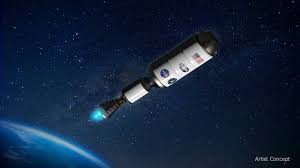NASA has unveiled ambitious new plans for Mars missions, opting for nuclear propulsion in space. By harnessing nuclear power, the agency aims to significantly shorten the duration of crewed trips to Mars, ultimately streamlining the process and enhancing astronaut safety.
Table of Contents
Heading Towards the Stars
In a momentous announcement, NASA and the US government-led Defense Advanced Research Projects Agency (DARPA) have unveiled an ambitious leap forward in their grand vision for space exploration. The two prominent agencies have entrusted the renowned aerospace manufacturer, Lockheed Martin, with the task of designing, building, and testing a cutting-edge nuclear-powered rocket.
Named the Demonstration Rocket for Agile Cislunar Operations (DRACO), this groundbreaking project aims to revolutionize space travel by harnessing the unprecedented efficiency of nuclear propulsion. Anticipation builds as DRACO is slated for space testing by the year 2027, promising to redefine the future of space missions and unlock new horizons for humanity’s exploration of the cosmos.
Unlocking New Horizons with Nuclear-Powered Rockets
Conventional rocket propulsion has long been the primary mode of transportation for space missions. However, as humanity dreams of venturing deeper into the cosmos and reaching destinations like Mars and beyond, it has become evident that traditional rockets have their limitations. The visionary solution lies in nuclear-powered rockets, which offer more than twice the efficiency of their conventional counterparts. These advanced propulsion systems hold the potential to drastically reduce travel times and open up possibilities for crewed missions to distant celestial bodies that were once deemed unattainable.
Entrusting Lockheed Martin: The Key to Success
Recognized as a pioneering force in aerospace engineering and innovation, Lockheed Martin has been chosen to spearhead the DRACO project. The decision to engage Lockheed Martin reflects the agency’s confidence in its capabilities to tackle complex challenges and deliver cutting-edge solutions. As the primary contractor, Lockheed Martin’s responsibilities encompass the entire lifecycle of the spacecraft – from the initial design phase to the critical integration of nuclear propulsion technology and the rigorous testing required to ensure mission success
The DRACO Mission: A Journey into the Unknown
The Demonstration Rocket for Agile Cislunar Operations (DRACO) embarks on an unprecedented journey into the realm of nuclear-powered propulsion. The project’s ultimate goal is to showcase the capabilities and viability of this innovative technology, thereby setting the stage for future space missions. By initiating this mission, NASA and DARPA are taking a bold step towards establishing a sustainable and efficient mode of space travel that has the potential to revolutionize human exploration beyond Earth’s orbit.
Advancing Cislunar Operations: The DRACO Impetus
The term “cislunar” refers to the region between Earth and the Moon, and this is where DRACO aims to demonstrate its prowess. By adopting nuclear-powered propulsion, DRACO seeks to enable agile and versatile operations in this crucial space corridor, unlocking a range of possibilities for future missions. These missions could involve lunar exploration, satellite servicing, asteroid mining, or even as stepping stones for deep space voyages.
Emphasizing Safety and Efficiency
One of the primary reasons driving the adoption of nuclear-powered rockets is the enhancement of astronaut safety during long-duration missions. Traditional chemical rockets demand extended periods for interplanetary travel, exposing astronauts to prolonged radiation and microgravity conditions. Nuclear propulsion technology can significantly shorten these travel times, thereby reducing the risks associated with extended space missions.
Moreover, increased efficiency translates into optimized mission planning and resource management. Shorter travel times enable the transportation of larger payloads, facilitate more frequent missions, and improve overall mission success rates. By leveraging nuclear-powered rockets, space agencies can maximize the scientific output of each mission while ensuring the safety and well-being of their astronaut crews.
Challenges and Contingencies
As with any groundbreaking endeavour, the DRACO project does not come without its share of challenges. Developing and implementing nuclear propulsion technology necessitates rigorous safety measures and thorough testing to prevent potential mishaps or radioactive contamination. Additionally, public acceptance and regulatory approvals may pose hurdles that need to be addressed transparently and effectively.
In light of these challenges, NASA and DARPA remain committed to meticulous planning and execution. With safety as a top priority, they will work in tandem with Lockheed Martin to implement rigorous safety protocols, adhere to stringent regulations, and conduct extensive testing to ensure the successful demonstration of DRACO’s capabilities.
Looking Ahead: A Bright Future for Space Exploration for NASA
The selection of Lockheed Martin for the DRACO project marks an exciting milestone in humanity’s journey towards space exploration. As the project advances, it holds the potential to revolutionize the way we approach interplanetary travel, making space missions more efficient, safer, and sustainable.
With the successful demonstration of nuclear-powered rockets through DRACO, we inch closer to unlocking the vast mysteries of the cosmos, propelling our civilization towards a future where humanity ventures farther and deeper into space, driven by the desire to explore and understand the wonders that lie beyond our celestial home.













